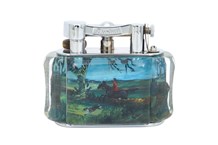The well-publicised case involving the Countess of Wemyss and March in a claim against Simon Dickinson Limited went to the Court of Appeal on June 21, on appeal from the High Court Judgment in which the Judge ruled in favour of Dickinson, who emerged victorious.
The issues were neatly defined by Lady Justice Falk who gave Judgment in the Court of Appeal:
“The fundamental issue between the parties relates to the extent to which the Painting [Le Bénédicité] should have been attributed to Jean-Baptiste-Siméon Chardin. In outline, the defendant sold the painting to a dealer for £1.15m as ‘Chardin and Studio’.
“The trustees say that there was at least a chance that the painting could have been sold for considerably more on the basis of a full attribution to Chardin. They rely on the fact that the painting was subsequently sold by the dealer for what was apparently a much higher price. The painting had been sent to the defendant for cleaning and assessment for a possible sale, and the trustees maintain that there should have been a further discussion about attribution and possible next steps before a sale was made.” [Para 2]
The “apparently … much higher price” was booked at $10.5m, which included $7.5m in cash and the delivery of a painting by Watteau, valued at $3m (though it was apparently common ground that this valuation was a “bizarre overestimate”). There were a number of grounds on which the Countess of Wemyss and the trustees of her estate sought to appeal.
The Court of Appeal’s comments with regard to one particular ground may be of some interest to those in the trade.
The aggrieved appellants had maintained throughout that “given his previously published views on the painting there was a duty either to approach the leading expert on Chardin, Monsieur Pierre Rosenberg, following cleaning to seek to confirm the attribution, or at least to advise the trustees about the potential benefits of doing so.
“There was a duty to advise that there was a real possibility that the painting could be worth considerably more than the proposed sale price, that the painting was not being sold as a ‘Chardin’ but as ‘Chardin and Studio’, that it was being sold to a dealer rather than on a retail basis and that the price was a ‘best guess’ or was ‘fudged’.” [Para 5]
And, importantly, they also claimed that “the Judge had also erred in relying on the subjective views of Mr Dickinson whereas he should have applied an objective test”.
Dealers interest
The finding that could be of particular interest to dealers is as follows:
“Mr Legge [Counsel for Dickinson] showed us that Mr Onslow [Counsel for Countess of Wemyss] had conceded at trial that the trustees would have followed Mr Dickinson’s advice. The trustees also did not establish that Mr Dickinson’s views were negligent. Mr Dickinson’s opinion that the painting was only partly by Chardin and so should not be fully attributed to him was not successfully challenged.
“In relation to whether Mr Rosenberg should be consulted the judge found that the decision not to do so was not negligent, because doing so would be a ‘spin of the roulette wheel’ that could destroy, rather than enhance, the value of the painting.
“The context for that finding included the acceptance by the well-publicised case involving the Countess of Wemyss and March in a claim against Simon Dickinson Limited went to the Court of Appeal on June 21, on appeal from the High Court Judgment in which the Judge ruled in favour of Dickinson, who emerged victorious.
The issues were neatly defined by Lady Justice Falk who gave Judgment in the Court of Appeal:
“The fundamental issue between the parties relates to the extent to which the Painting [Le Bénédicité] should have been attributed to Jean-Baptiste-Siméon Chardin. In outline, the defendant sold the painting to a dealer for £1.15m as ‘Chardin and Studio’.
“The trustees say that there was at least a chance that the painting could have been sold for considerably more on the basis of a full attribution to Chardin. They rely on the fact that the painting was subsequently sold by the dealer for what was apparently a much higher price. The painting had been sent to the defendant for cleaning and assessment for a possible sale, and the trustees maintain that there should have been a further discussion about attribution and possible next steps before a sale was made.” [Para 2]
The “apparently … much higher price” was booked at $10.5m, which included $7.5m in cash and the delivery of a painting by Watteau, valued at $3m (though it was apparently common ground that this valuation was a “bizarre overestimate”). There were a number of grounds on which the Countess of Wemyss and the trustees of her estate sought to appeal.
The Court of Appeal’s comments with regard to one particular ground may be of some interest to those in the trade.
The aggrieved appellants had maintained throughout that “given his previously published views on the painting there was a duty either to approach the leading expert on Chardin, Monsieur Pierre Rosenberg, following cleaning to seek to confirm the attribution, or at least to advise the trustees about the potential benefits of doing so.
“There was a duty to advise that there was a real possibility that the painting could be worth considerably more than the proposed sale price, that the painting was not being sold as a ‘Chardin’ but as ‘Chardin and Studio’, that it was being sold to a dealer rather than on a retail basis and that the price was a ‘best guess’ or was ‘fudged’.” [Para 5]
And, importantly, they also claimed that “the Judge had also erred in relying on the subjective views of Mr Dickinson whereas he should have applied an objective test”.
The finding that could be of particular interest to dealers is as follows:
“Mr Legge [Counsel for Dickinson] showed us that Mr Onslow [Counsel for Countess of Wemyss] had conceded at trial that the trustees would have followed Mr Dickinson’s advice. The trustees also did not establish that Mr Dickinson’s views were negligent. Mr Dickinson’s opinion that the painting was only partly by Chardin and so should not be fully attributed to him was not successfully challenged.
“In relation to whether Mr Rosenberg should be consulted the judge found that the decision not to do so was not negligent, because doing so would be a ‘spin of the roulette wheel’ that could destroy, rather than enhance, the value of the painting.
“The context for that finding included the acceptance by the
The Court of Appeal then says: “Therefore, in a counterfactual world where the defendant did consult the trustees prior to sale the advice would not have been negligent and the trustees would have followed that advice. It follows that the painting would still have been sold on the terms that it was.”
Expertise backed
The bottom line: acceptance by the Court of Appeal on the above points (and others) of what the High Court judge found.
It is worth re-reading and reflecting carefully on what is said in the quoted paragraphs in these last two columns.
Fundamental to the findings is the High Court Judge’s confidence in the expertise of Simon Dickinson, and the Court of Appeal’s subsequent acceptance of those findings.
The courts’ acceptance of that expertise has won the day.
Milton Silverman is senior commercial dispute resolution partner at Streathers Solicitors LLP, London.










